Analyzing the Business Environment: M&S in the UK Retail Sector
VerifiedAdded on 2024/05/17
|26
|5876
|210
Report
AI Summary
This report provides a comprehensive analysis of the business environment within which Marks and Spencer (M&S) operates in the UK retail sector. It begins by differentiating between public, private, and non-governmental organizations, using Morrison's, M&S, and Waitrose as examples. The report explores the size and scope of these organizations, categorizing them as small, medium, or large enterprises, and analyzes their business objectives in relation to the products and services they offer. It also examines various organizational structures, including flat, hierarchical, departmentalized, centralized, and decentralized structures, and discusses the complexities of transnational, international, and global organizational structures. Furthermore, the report evaluates the positive and negative impacts of the macro environment on the UK retail sector, specifically focusing on M&S, and analyzes the company's strengths and weaknesses in relation to these impacts, and their interrelation with external macro factors. The analysis provides insights into how M&S can leverage its strengths and address its weaknesses in the face of environmental challenges and opportunities.
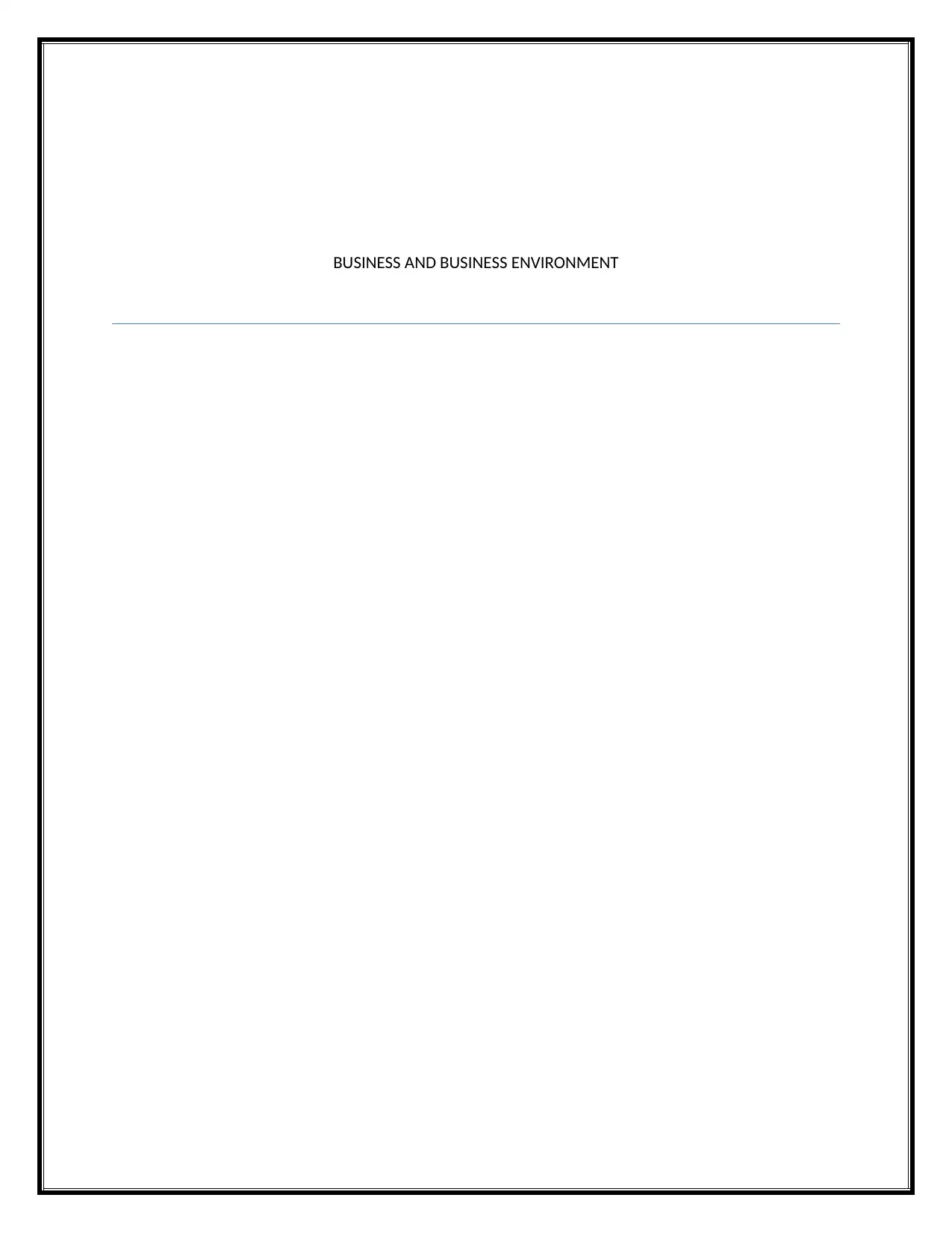
BUSINESS AND BUSINESS ENVIRONMENT
Paraphrase This Document
Need a fresh take? Get an instant paraphrase of this document with our AI Paraphraser
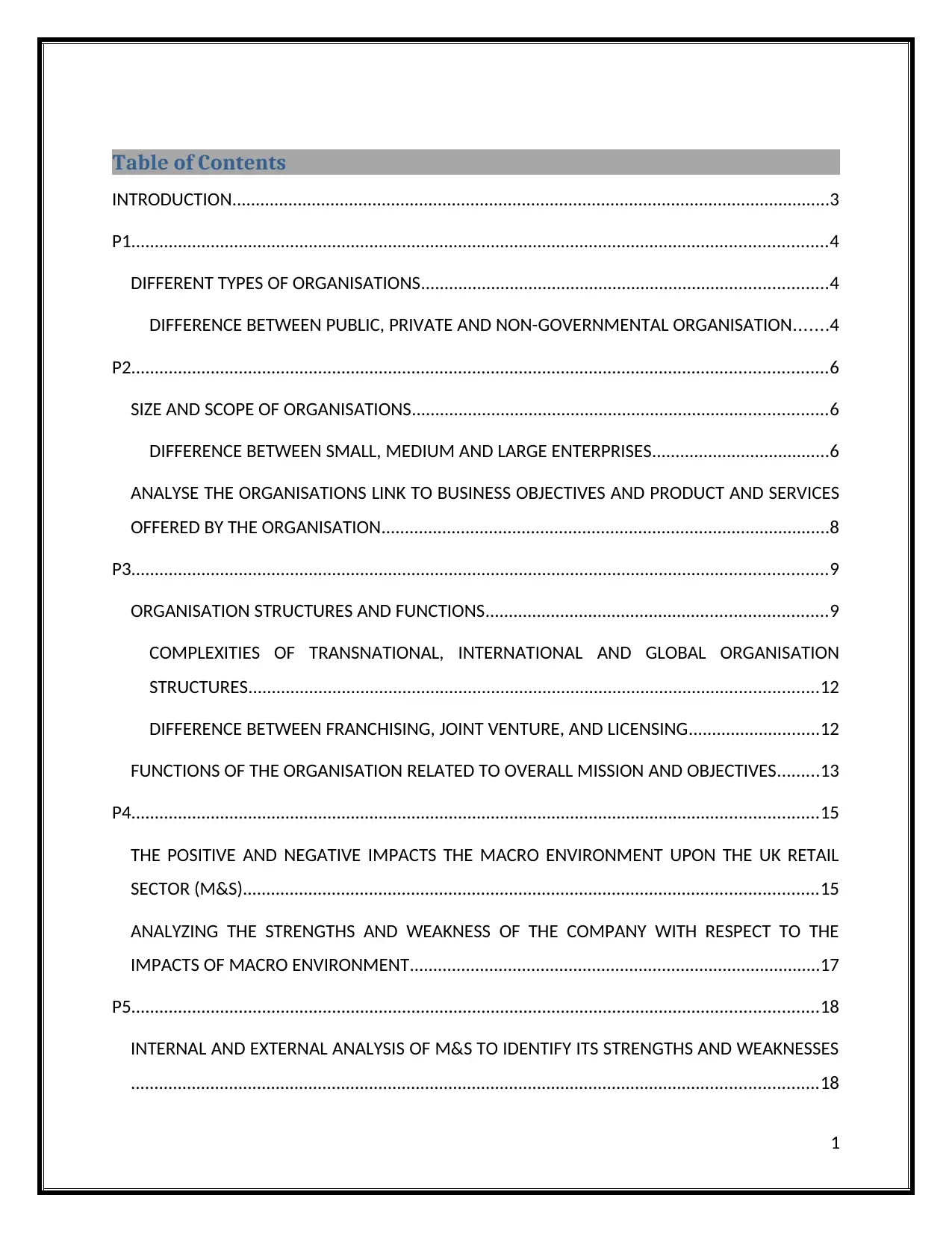
Table of Contents
INTRODUCTION................................................................................................................................3
P1.....................................................................................................................................................4
DIFFERENT TYPES OF ORGANISATIONS.......................................................................................4
DIFFERENCE BETWEEN PUBLIC, PRIVATE AND NON-GOVERNMENTAL ORGANISATION.......4
P2.....................................................................................................................................................6
SIZE AND SCOPE OF ORGANISATIONS.........................................................................................6
DIFFERENCE BETWEEN SMALL, MEDIUM AND LARGE ENTERPRISES......................................6
ANALYSE THE ORGANISATIONS LINK TO BUSINESS OBJECTIVES AND PRODUCT AND SERVICES
OFFERED BY THE ORGANISATION................................................................................................8
P3.....................................................................................................................................................9
ORGANISATION STRUCTURES AND FUNCTIONS.........................................................................9
COMPLEXITIES OF TRANSNATIONAL, INTERNATIONAL AND GLOBAL ORGANISATION
STRUCTURES..........................................................................................................................12
DIFFERENCE BETWEEN FRANCHISING, JOINT VENTURE, AND LICENSING............................12
FUNCTIONS OF THE ORGANISATION RELATED TO OVERALL MISSION AND OBJECTIVES.........13
P4...................................................................................................................................................15
THE POSITIVE AND NEGATIVE IMPACTS THE MACRO ENVIRONMENT UPON THE UK RETAIL
SECTOR (M&S)...........................................................................................................................15
ANALYZING THE STRENGTHS AND WEAKNESS OF THE COMPANY WITH RESPECT TO THE
IMPACTS OF MACRO ENVIRONMENT........................................................................................17
P5...................................................................................................................................................18
INTERNAL AND EXTERNAL ANALYSIS OF M&S TO IDENTIFY ITS STRENGTHS AND WEAKNESSES
...................................................................................................................................................18
1
INTRODUCTION................................................................................................................................3
P1.....................................................................................................................................................4
DIFFERENT TYPES OF ORGANISATIONS.......................................................................................4
DIFFERENCE BETWEEN PUBLIC, PRIVATE AND NON-GOVERNMENTAL ORGANISATION.......4
P2.....................................................................................................................................................6
SIZE AND SCOPE OF ORGANISATIONS.........................................................................................6
DIFFERENCE BETWEEN SMALL, MEDIUM AND LARGE ENTERPRISES......................................6
ANALYSE THE ORGANISATIONS LINK TO BUSINESS OBJECTIVES AND PRODUCT AND SERVICES
OFFERED BY THE ORGANISATION................................................................................................8
P3.....................................................................................................................................................9
ORGANISATION STRUCTURES AND FUNCTIONS.........................................................................9
COMPLEXITIES OF TRANSNATIONAL, INTERNATIONAL AND GLOBAL ORGANISATION
STRUCTURES..........................................................................................................................12
DIFFERENCE BETWEEN FRANCHISING, JOINT VENTURE, AND LICENSING............................12
FUNCTIONS OF THE ORGANISATION RELATED TO OVERALL MISSION AND OBJECTIVES.........13
P4...................................................................................................................................................15
THE POSITIVE AND NEGATIVE IMPACTS THE MACRO ENVIRONMENT UPON THE UK RETAIL
SECTOR (M&S)...........................................................................................................................15
ANALYZING THE STRENGTHS AND WEAKNESS OF THE COMPANY WITH RESPECT TO THE
IMPACTS OF MACRO ENVIRONMENT........................................................................................17
P5...................................................................................................................................................18
INTERNAL AND EXTERNAL ANALYSIS OF M&S TO IDENTIFY ITS STRENGTHS AND WEAKNESSES
...................................................................................................................................................18
1
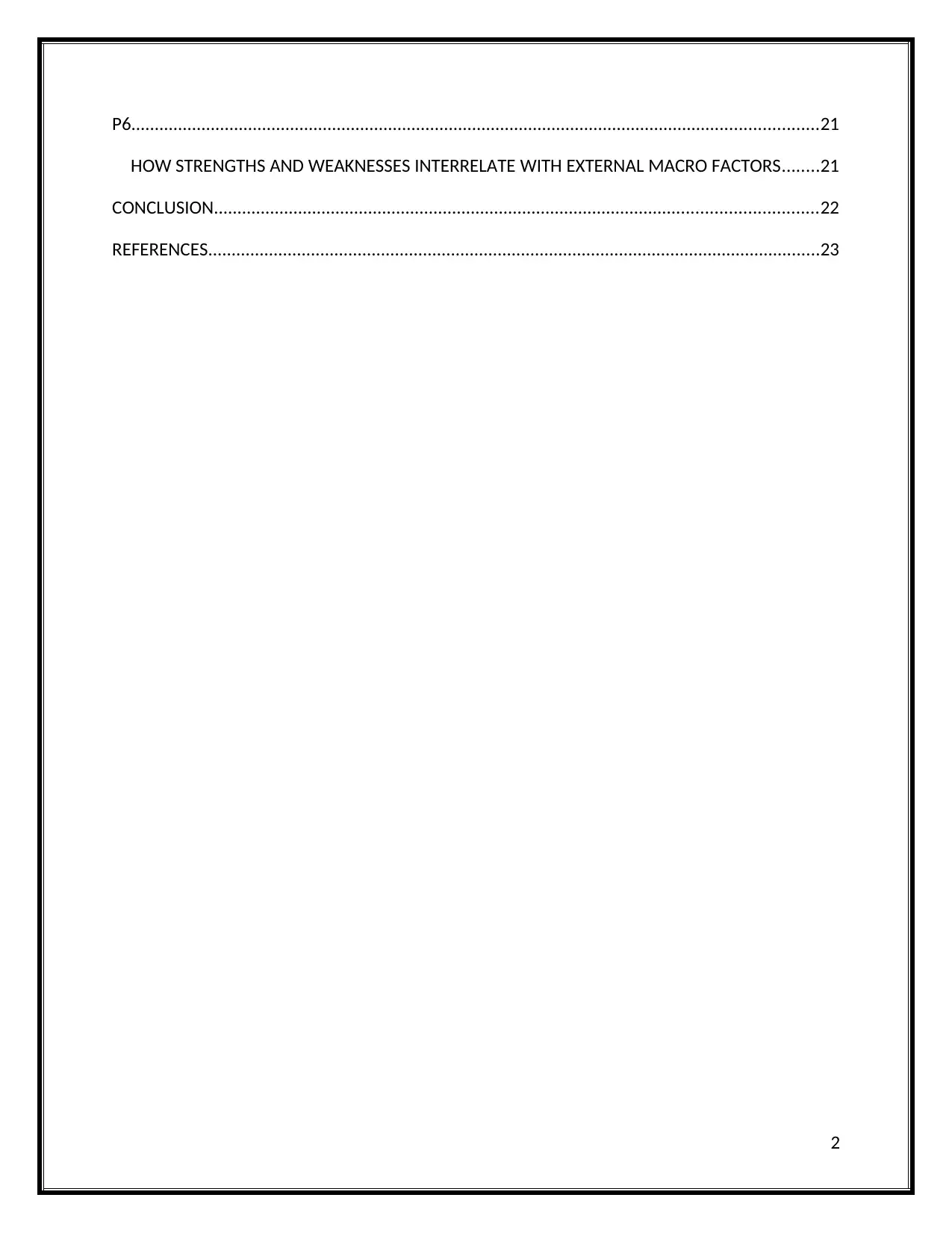
P6...................................................................................................................................................21
HOW STRENGTHS AND WEAKNESSES INTERRELATE WITH EXTERNAL MACRO FACTORS........21
CONCLUSION.................................................................................................................................22
REFERENCES...................................................................................................................................23
2
HOW STRENGTHS AND WEAKNESSES INTERRELATE WITH EXTERNAL MACRO FACTORS........21
CONCLUSION.................................................................................................................................22
REFERENCES...................................................................................................................................23
2
⊘ This is a preview!⊘
Do you want full access?
Subscribe today to unlock all pages.

Trusted by 1+ million students worldwide
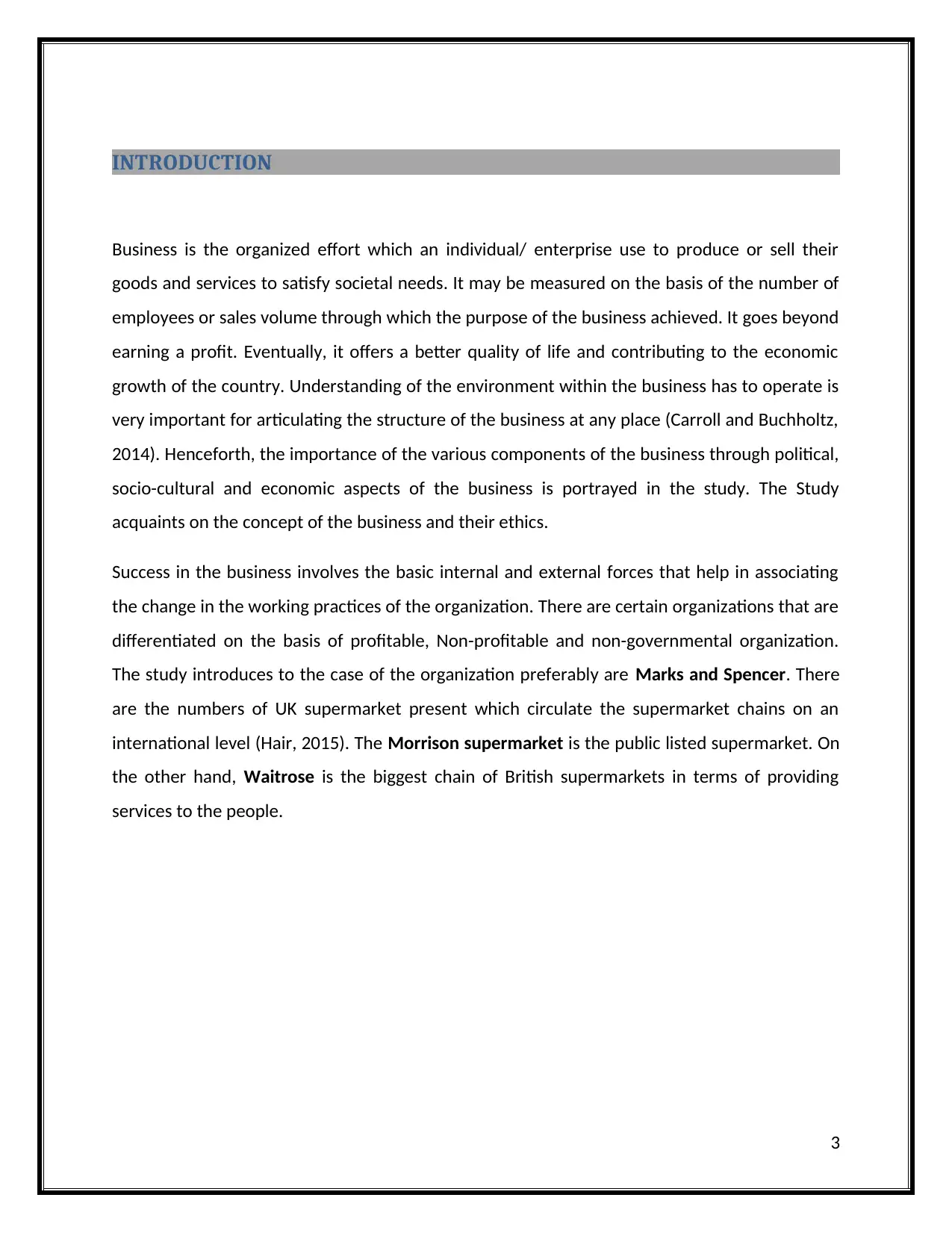
INTRODUCTION
Business is the organized effort which an individual/ enterprise use to produce or sell their
goods and services to satisfy societal needs. It may be measured on the basis of the number of
employees or sales volume through which the purpose of the business achieved. It goes beyond
earning a profit. Eventually, it offers a better quality of life and contributing to the economic
growth of the country. Understanding of the environment within the business has to operate is
very important for articulating the structure of the business at any place (Carroll and Buchholtz,
2014). Henceforth, the importance of the various components of the business through political,
socio-cultural and economic aspects of the business is portrayed in the study. The Study
acquaints on the concept of the business and their ethics.
Success in the business involves the basic internal and external forces that help in associating
the change in the working practices of the organization. There are certain organizations that are
differentiated on the basis of profitable, Non-profitable and non-governmental organization.
The study introduces to the case of the organization preferably are Marks and Spencer. There
are the numbers of UK supermarket present which circulate the supermarket chains on an
international level (Hair, 2015). The Morrison supermarket is the public listed supermarket. On
the other hand, Waitrose is the biggest chain of British supermarkets in terms of providing
services to the people.
3
Business is the organized effort which an individual/ enterprise use to produce or sell their
goods and services to satisfy societal needs. It may be measured on the basis of the number of
employees or sales volume through which the purpose of the business achieved. It goes beyond
earning a profit. Eventually, it offers a better quality of life and contributing to the economic
growth of the country. Understanding of the environment within the business has to operate is
very important for articulating the structure of the business at any place (Carroll and Buchholtz,
2014). Henceforth, the importance of the various components of the business through political,
socio-cultural and economic aspects of the business is portrayed in the study. The Study
acquaints on the concept of the business and their ethics.
Success in the business involves the basic internal and external forces that help in associating
the change in the working practices of the organization. There are certain organizations that are
differentiated on the basis of profitable, Non-profitable and non-governmental organization.
The study introduces to the case of the organization preferably are Marks and Spencer. There
are the numbers of UK supermarket present which circulate the supermarket chains on an
international level (Hair, 2015). The Morrison supermarket is the public listed supermarket. On
the other hand, Waitrose is the biggest chain of British supermarkets in terms of providing
services to the people.
3
Paraphrase This Document
Need a fresh take? Get an instant paraphrase of this document with our AI Paraphraser
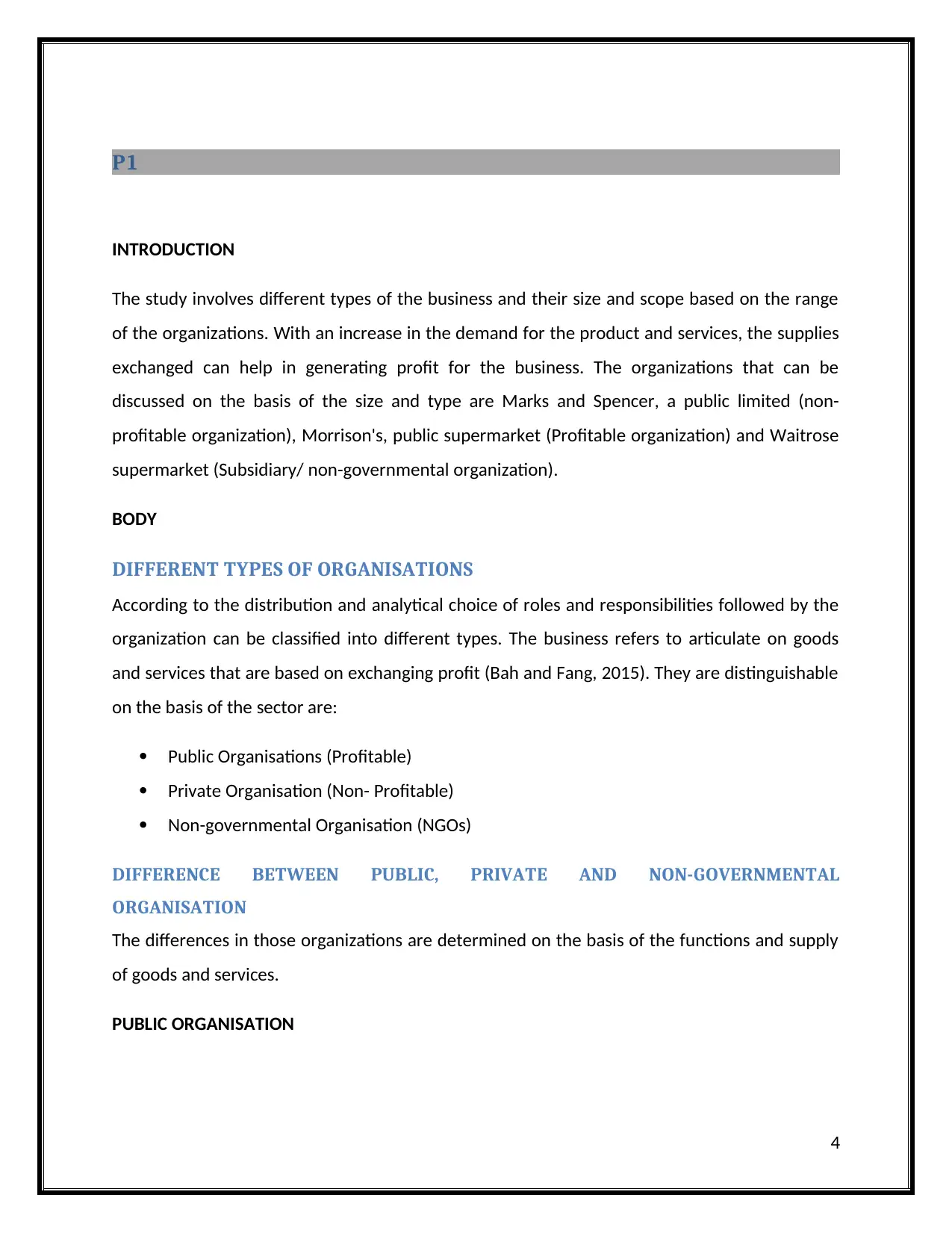
P1
INTRODUCTION
The study involves different types of the business and their size and scope based on the range
of the organizations. With an increase in the demand for the product and services, the supplies
exchanged can help in generating profit for the business. The organizations that can be
discussed on the basis of the size and type are Marks and Spencer, a public limited (non-
profitable organization), Morrison's, public supermarket (Profitable organization) and Waitrose
supermarket (Subsidiary/ non-governmental organization).
BODY
DIFFERENT TYPES OF ORGANISATIONS
According to the distribution and analytical choice of roles and responsibilities followed by the
organization can be classified into different types. The business refers to articulate on goods
and services that are based on exchanging profit (Bah and Fang, 2015). They are distinguishable
on the basis of the sector are:
Public Organisations (Profitable)
Private Organisation (Non- Profitable)
Non-governmental Organisation (NGOs)
DIFFERENCE BETWEEN PUBLIC, PRIVATE AND NON-GOVERNMENTAL
ORGANISATION
The differences in those organizations are determined on the basis of the functions and supply
of goods and services.
PUBLIC ORGANISATION
4
INTRODUCTION
The study involves different types of the business and their size and scope based on the range
of the organizations. With an increase in the demand for the product and services, the supplies
exchanged can help in generating profit for the business. The organizations that can be
discussed on the basis of the size and type are Marks and Spencer, a public limited (non-
profitable organization), Morrison's, public supermarket (Profitable organization) and Waitrose
supermarket (Subsidiary/ non-governmental organization).
BODY
DIFFERENT TYPES OF ORGANISATIONS
According to the distribution and analytical choice of roles and responsibilities followed by the
organization can be classified into different types. The business refers to articulate on goods
and services that are based on exchanging profit (Bah and Fang, 2015). They are distinguishable
on the basis of the sector are:
Public Organisations (Profitable)
Private Organisation (Non- Profitable)
Non-governmental Organisation (NGOs)
DIFFERENCE BETWEEN PUBLIC, PRIVATE AND NON-GOVERNMENTAL
ORGANISATION
The differences in those organizations are determined on the basis of the functions and supply
of goods and services.
PUBLIC ORGANISATION
4
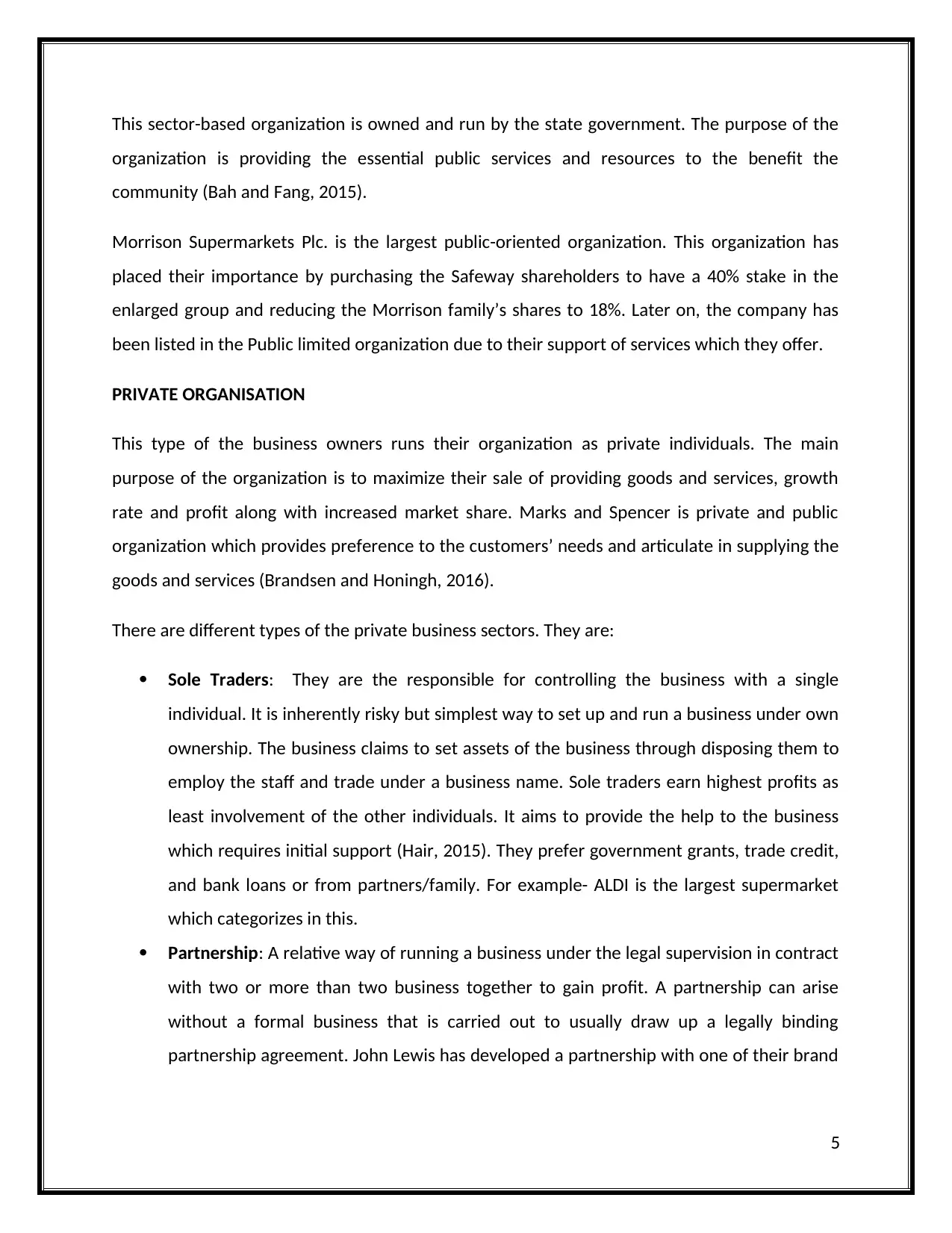
This sector-based organization is owned and run by the state government. The purpose of the
organization is providing the essential public services and resources to the benefit the
community (Bah and Fang, 2015).
Morrison Supermarkets Plc. is the largest public-oriented organization. This organization has
placed their importance by purchasing the Safeway shareholders to have a 40% stake in the
enlarged group and reducing the Morrison family’s shares to 18%. Later on, the company has
been listed in the Public limited organization due to their support of services which they offer.
PRIVATE ORGANISATION
This type of the business owners runs their organization as private individuals. The main
purpose of the organization is to maximize their sale of providing goods and services, growth
rate and profit along with increased market share. Marks and Spencer is private and public
organization which provides preference to the customers’ needs and articulate in supplying the
goods and services (Brandsen and Honingh, 2016).
There are different types of the private business sectors. They are:
Sole Traders: They are the responsible for controlling the business with a single
individual. It is inherently risky but simplest way to set up and run a business under own
ownership. The business claims to set assets of the business through disposing them to
employ the staff and trade under a business name. Sole traders earn highest profits as
least involvement of the other individuals. It aims to provide the help to the business
which requires initial support (Hair, 2015). They prefer government grants, trade credit,
and bank loans or from partners/family. For example- ALDI is the largest supermarket
which categorizes in this.
Partnership: A relative way of running a business under the legal supervision in contract
with two or more than two business together to gain profit. A partnership can arise
without a formal business that is carried out to usually draw up a legally binding
partnership agreement. John Lewis has developed a partnership with one of their brand
5
organization is providing the essential public services and resources to the benefit the
community (Bah and Fang, 2015).
Morrison Supermarkets Plc. is the largest public-oriented organization. This organization has
placed their importance by purchasing the Safeway shareholders to have a 40% stake in the
enlarged group and reducing the Morrison family’s shares to 18%. Later on, the company has
been listed in the Public limited organization due to their support of services which they offer.
PRIVATE ORGANISATION
This type of the business owners runs their organization as private individuals. The main
purpose of the organization is to maximize their sale of providing goods and services, growth
rate and profit along with increased market share. Marks and Spencer is private and public
organization which provides preference to the customers’ needs and articulate in supplying the
goods and services (Brandsen and Honingh, 2016).
There are different types of the private business sectors. They are:
Sole Traders: They are the responsible for controlling the business with a single
individual. It is inherently risky but simplest way to set up and run a business under own
ownership. The business claims to set assets of the business through disposing them to
employ the staff and trade under a business name. Sole traders earn highest profits as
least involvement of the other individuals. It aims to provide the help to the business
which requires initial support (Hair, 2015). They prefer government grants, trade credit,
and bank loans or from partners/family. For example- ALDI is the largest supermarket
which categorizes in this.
Partnership: A relative way of running a business under the legal supervision in contract
with two or more than two business together to gain profit. A partnership can arise
without a formal business that is carried out to usually draw up a legally binding
partnership agreement. John Lewis has developed a partnership with one of their brand
5
⊘ This is a preview!⊘
Do you want full access?
Subscribe today to unlock all pages.

Trusted by 1+ million students worldwide
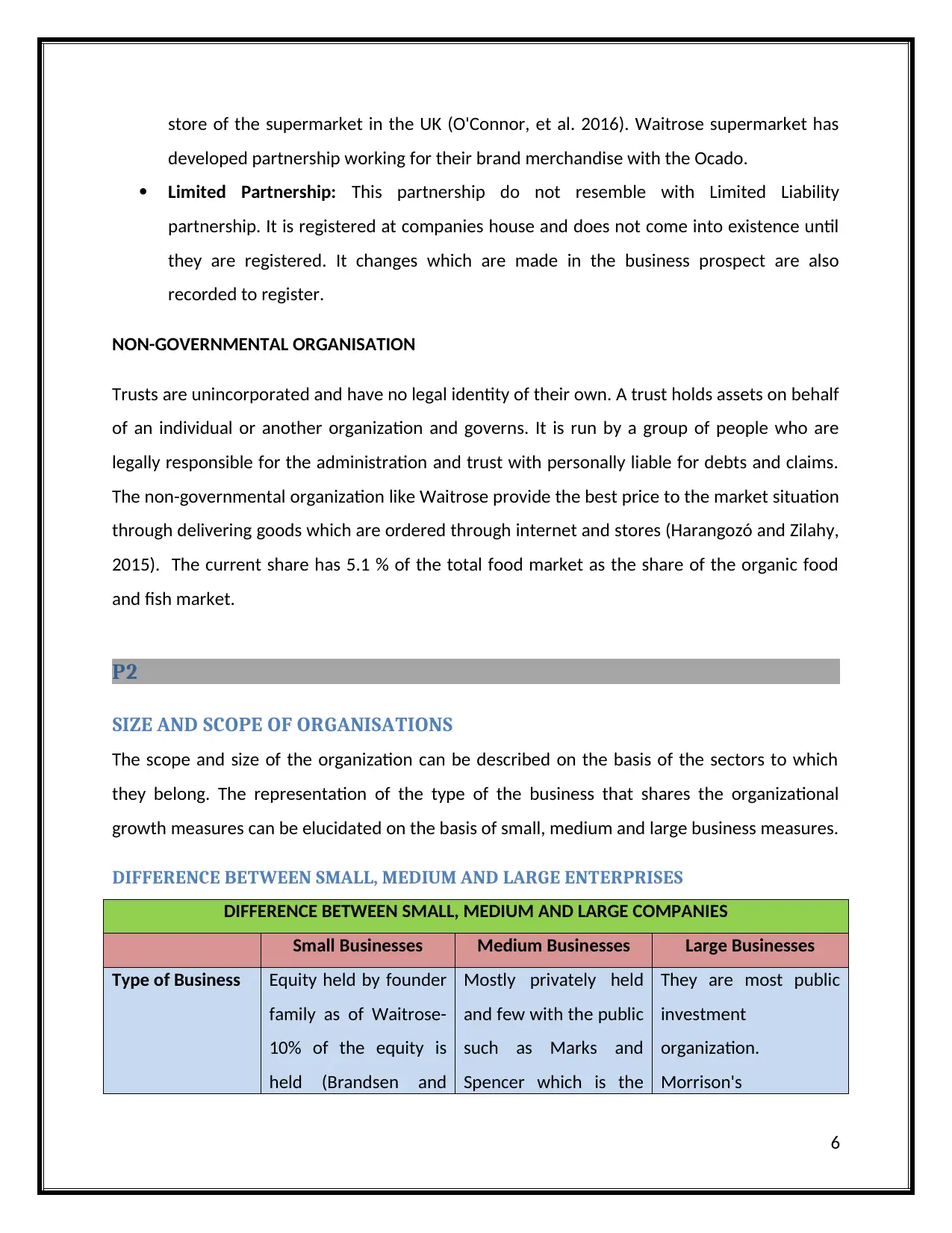
store of the supermarket in the UK (O'Connor, et al. 2016). Waitrose supermarket has
developed partnership working for their brand merchandise with the Ocado.
Limited Partnership: This partnership do not resemble with Limited Liability
partnership. It is registered at companies house and does not come into existence until
they are registered. It changes which are made in the business prospect are also
recorded to register.
NON-GOVERNMENTAL ORGANISATION
Trusts are unincorporated and have no legal identity of their own. A trust holds assets on behalf
of an individual or another organization and governs. It is run by a group of people who are
legally responsible for the administration and trust with personally liable for debts and claims.
The non-governmental organization like Waitrose provide the best price to the market situation
through delivering goods which are ordered through internet and stores (Harangozó and Zilahy,
2015). The current share has 5.1 % of the total food market as the share of the organic food
and fish market.
P2
SIZE AND SCOPE OF ORGANISATIONS
The scope and size of the organization can be described on the basis of the sectors to which
they belong. The representation of the type of the business that shares the organizational
growth measures can be elucidated on the basis of small, medium and large business measures.
DIFFERENCE BETWEEN SMALL, MEDIUM AND LARGE ENTERPRISES
DIFFERENCE BETWEEN SMALL, MEDIUM AND LARGE COMPANIES
Small Businesses Medium Businesses Large Businesses
Type of Business Equity held by founder
family as of Waitrose-
10% of the equity is
held (Brandsen and
Mostly privately held
and few with the public
such as Marks and
Spencer which is the
They are most public
investment
organization.
Morrison's
6
developed partnership working for their brand merchandise with the Ocado.
Limited Partnership: This partnership do not resemble with Limited Liability
partnership. It is registered at companies house and does not come into existence until
they are registered. It changes which are made in the business prospect are also
recorded to register.
NON-GOVERNMENTAL ORGANISATION
Trusts are unincorporated and have no legal identity of their own. A trust holds assets on behalf
of an individual or another organization and governs. It is run by a group of people who are
legally responsible for the administration and trust with personally liable for debts and claims.
The non-governmental organization like Waitrose provide the best price to the market situation
through delivering goods which are ordered through internet and stores (Harangozó and Zilahy,
2015). The current share has 5.1 % of the total food market as the share of the organic food
and fish market.
P2
SIZE AND SCOPE OF ORGANISATIONS
The scope and size of the organization can be described on the basis of the sectors to which
they belong. The representation of the type of the business that shares the organizational
growth measures can be elucidated on the basis of small, medium and large business measures.
DIFFERENCE BETWEEN SMALL, MEDIUM AND LARGE ENTERPRISES
DIFFERENCE BETWEEN SMALL, MEDIUM AND LARGE COMPANIES
Small Businesses Medium Businesses Large Businesses
Type of Business Equity held by founder
family as of Waitrose-
10% of the equity is
held (Brandsen and
Mostly privately held
and few with the public
such as Marks and
Spencer which is the
They are most public
investment
organization.
Morrison's
6
Paraphrase This Document
Need a fresh take? Get an instant paraphrase of this document with our AI Paraphraser
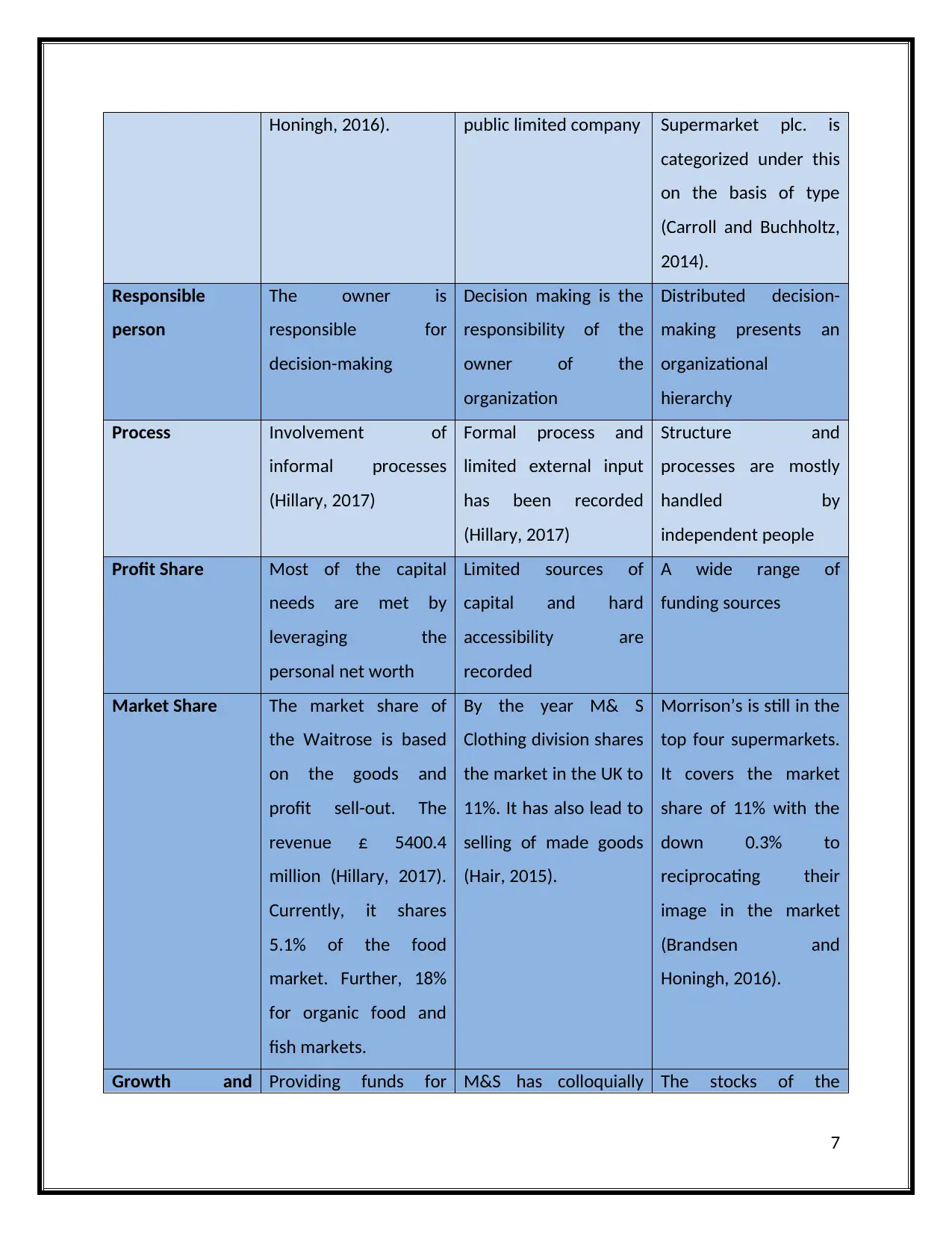
Honingh, 2016). public limited company Supermarket plc. is
categorized under this
on the basis of type
(Carroll and Buchholtz,
2014).
Responsible
person
The owner is
responsible for
decision-making
Decision making is the
responsibility of the
owner of the
organization
Distributed decision-
making presents an
organizational
hierarchy
Process Involvement of
informal processes
(Hillary, 2017)
Formal process and
limited external input
has been recorded
(Hillary, 2017)
Structure and
processes are mostly
handled by
independent people
Profit Share Most of the capital
needs are met by
leveraging the
personal net worth
Limited sources of
capital and hard
accessibility are
recorded
A wide range of
funding sources
Market Share The market share of
the Waitrose is based
on the goods and
profit sell-out. The
revenue £ 5400.4
million (Hillary, 2017).
Currently, it shares
5.1% of the food
market. Further, 18%
for organic food and
fish markets.
By the year M& S
Clothing division shares
the market in the UK to
11%. It has also lead to
selling of made goods
(Hair, 2015).
Morrison’s is still in the
top four supermarkets.
It covers the market
share of 11% with the
down 0.3% to
reciprocating their
image in the market
(Brandsen and
Honingh, 2016).
Growth and Providing funds for M&S has colloquially The stocks of the
7
categorized under this
on the basis of type
(Carroll and Buchholtz,
2014).
Responsible
person
The owner is
responsible for
decision-making
Decision making is the
responsibility of the
owner of the
organization
Distributed decision-
making presents an
organizational
hierarchy
Process Involvement of
informal processes
(Hillary, 2017)
Formal process and
limited external input
has been recorded
(Hillary, 2017)
Structure and
processes are mostly
handled by
independent people
Profit Share Most of the capital
needs are met by
leveraging the
personal net worth
Limited sources of
capital and hard
accessibility are
recorded
A wide range of
funding sources
Market Share The market share of
the Waitrose is based
on the goods and
profit sell-out. The
revenue £ 5400.4
million (Hillary, 2017).
Currently, it shares
5.1% of the food
market. Further, 18%
for organic food and
fish markets.
By the year M& S
Clothing division shares
the market in the UK to
11%. It has also lead to
selling of made goods
(Hair, 2015).
Morrison’s is still in the
top four supermarkets.
It covers the market
share of 11% with the
down 0.3% to
reciprocating their
image in the market
(Brandsen and
Honingh, 2016).
Growth and Providing funds for M&S has colloquially The stocks of the
7
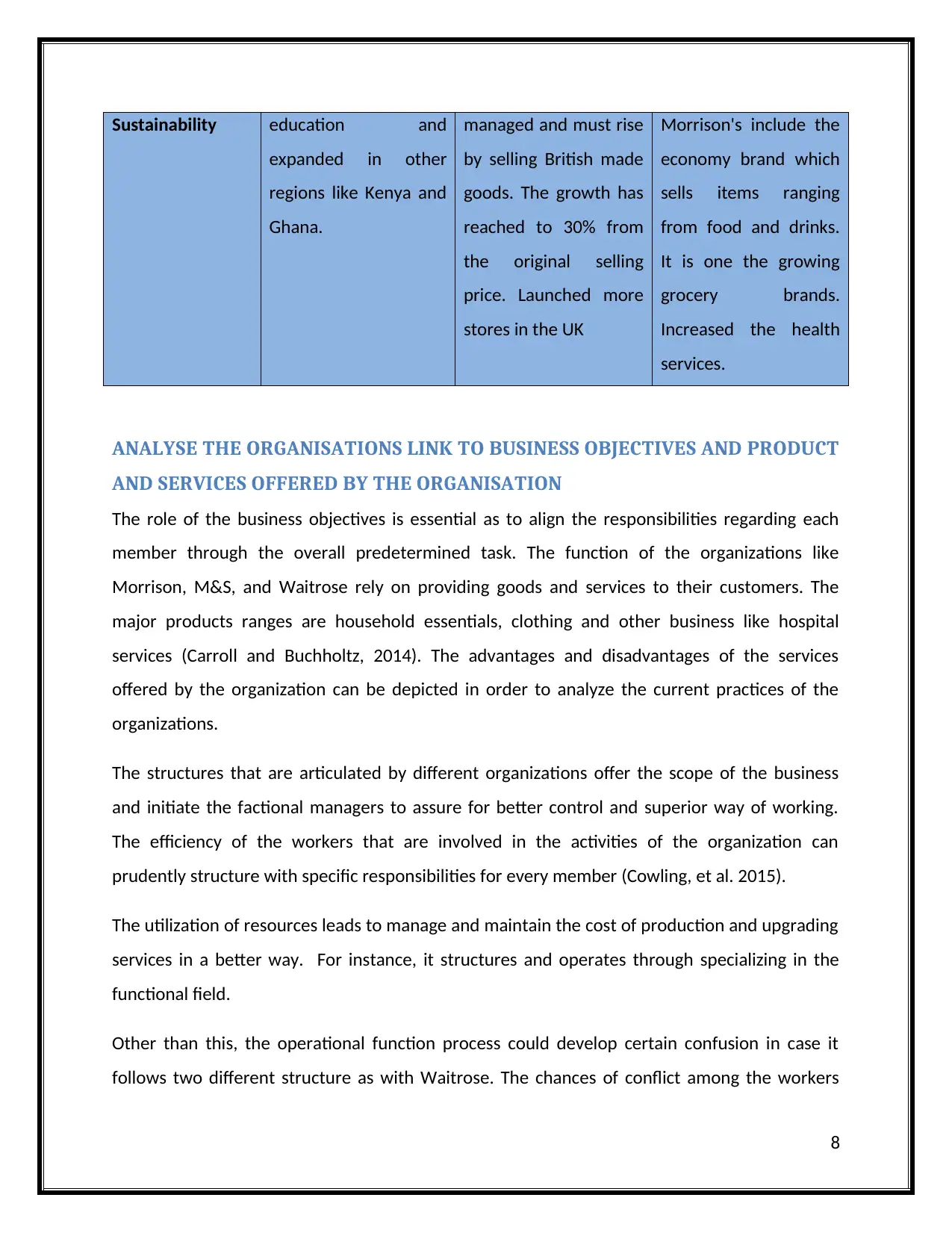
Sustainability education and
expanded in other
regions like Kenya and
Ghana.
managed and must rise
by selling British made
goods. The growth has
reached to 30% from
the original selling
price. Launched more
stores in the UK
Morrison's include the
economy brand which
sells items ranging
from food and drinks.
It is one the growing
grocery brands.
Increased the health
services.
ANALYSE THE ORGANISATIONS LINK TO BUSINESS OBJECTIVES AND PRODUCT
AND SERVICES OFFERED BY THE ORGANISATION
The role of the business objectives is essential as to align the responsibilities regarding each
member through the overall predetermined task. The function of the organizations like
Morrison, M&S, and Waitrose rely on providing goods and services to their customers. The
major products ranges are household essentials, clothing and other business like hospital
services (Carroll and Buchholtz, 2014). The advantages and disadvantages of the services
offered by the organization can be depicted in order to analyze the current practices of the
organizations.
The structures that are articulated by different organizations offer the scope of the business
and initiate the factional managers to assure for better control and superior way of working.
The efficiency of the workers that are involved in the activities of the organization can
prudently structure with specific responsibilities for every member (Cowling, et al. 2015).
The utilization of resources leads to manage and maintain the cost of production and upgrading
services in a better way. For instance, it structures and operates through specializing in the
functional field.
Other than this, the operational function process could develop certain confusion in case it
follows two different structure as with Waitrose. The chances of conflict among the workers
8
expanded in other
regions like Kenya and
Ghana.
managed and must rise
by selling British made
goods. The growth has
reached to 30% from
the original selling
price. Launched more
stores in the UK
Morrison's include the
economy brand which
sells items ranging
from food and drinks.
It is one the growing
grocery brands.
Increased the health
services.
ANALYSE THE ORGANISATIONS LINK TO BUSINESS OBJECTIVES AND PRODUCT
AND SERVICES OFFERED BY THE ORGANISATION
The role of the business objectives is essential as to align the responsibilities regarding each
member through the overall predetermined task. The function of the organizations like
Morrison, M&S, and Waitrose rely on providing goods and services to their customers. The
major products ranges are household essentials, clothing and other business like hospital
services (Carroll and Buchholtz, 2014). The advantages and disadvantages of the services
offered by the organization can be depicted in order to analyze the current practices of the
organizations.
The structures that are articulated by different organizations offer the scope of the business
and initiate the factional managers to assure for better control and superior way of working.
The efficiency of the workers that are involved in the activities of the organization can
prudently structure with specific responsibilities for every member (Cowling, et al. 2015).
The utilization of resources leads to manage and maintain the cost of production and upgrading
services in a better way. For instance, it structures and operates through specializing in the
functional field.
Other than this, the operational function process could develop certain confusion in case it
follows two different structure as with Waitrose. The chances of conflict among the workers
8
⊘ This is a preview!⊘
Do you want full access?
Subscribe today to unlock all pages.

Trusted by 1+ million students worldwide
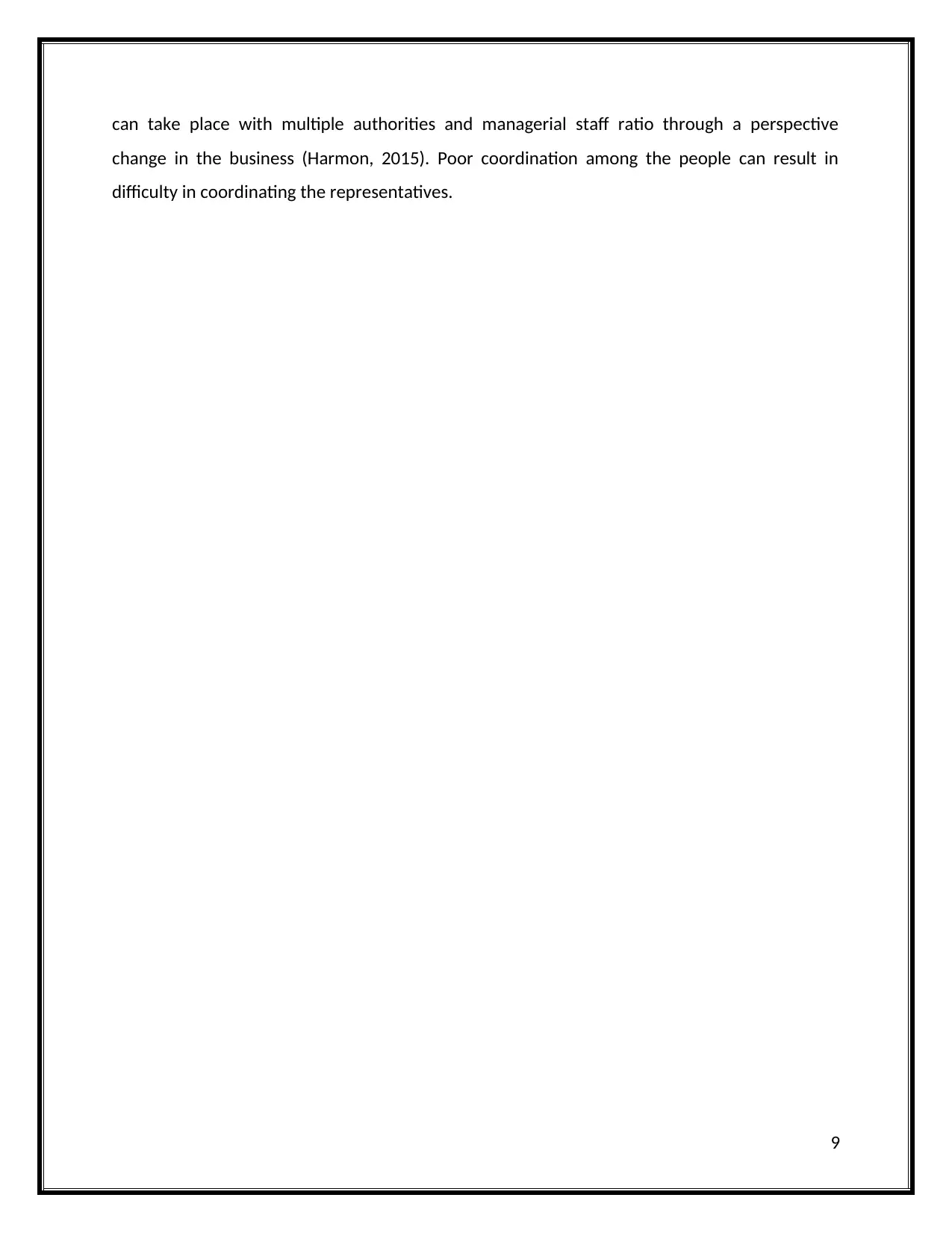
can take place with multiple authorities and managerial staff ratio through a perspective
change in the business (Harmon, 2015). Poor coordination among the people can result in
difficulty in coordinating the representatives.
9
change in the business (Harmon, 2015). Poor coordination among the people can result in
difficulty in coordinating the representatives.
9
Paraphrase This Document
Need a fresh take? Get an instant paraphrase of this document with our AI Paraphraser
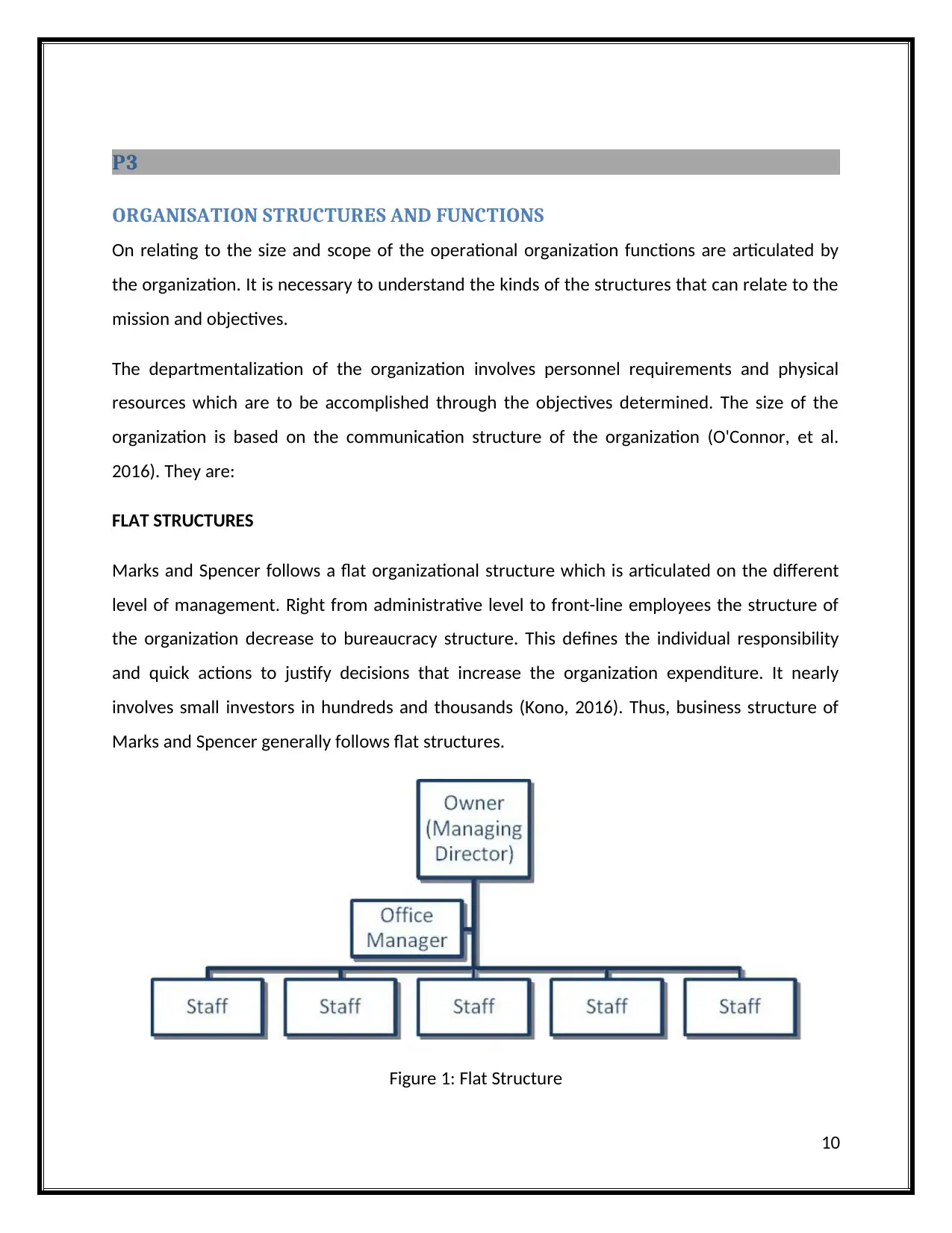
P3
ORGANISATION STRUCTURES AND FUNCTIONS
On relating to the size and scope of the operational organization functions are articulated by
the organization. It is necessary to understand the kinds of the structures that can relate to the
mission and objectives.
The departmentalization of the organization involves personnel requirements and physical
resources which are to be accomplished through the objectives determined. The size of the
organization is based on the communication structure of the organization (O'Connor, et al.
2016). They are:
FLAT STRUCTURES
Marks and Spencer follows a flat organizational structure which is articulated on the different
level of management. Right from administrative level to front-line employees the structure of
the organization decrease to bureaucracy structure. This defines the individual responsibility
and quick actions to justify decisions that increase the organization expenditure. It nearly
involves small investors in hundreds and thousands (Kono, 2016). Thus, business structure of
Marks and Spencer generally follows flat structures.
Figure 1: Flat Structure
10
ORGANISATION STRUCTURES AND FUNCTIONS
On relating to the size and scope of the operational organization functions are articulated by
the organization. It is necessary to understand the kinds of the structures that can relate to the
mission and objectives.
The departmentalization of the organization involves personnel requirements and physical
resources which are to be accomplished through the objectives determined. The size of the
organization is based on the communication structure of the organization (O'Connor, et al.
2016). They are:
FLAT STRUCTURES
Marks and Spencer follows a flat organizational structure which is articulated on the different
level of management. Right from administrative level to front-line employees the structure of
the organization decrease to bureaucracy structure. This defines the individual responsibility
and quick actions to justify decisions that increase the organization expenditure. It nearly
involves small investors in hundreds and thousands (Kono, 2016). Thus, business structure of
Marks and Spencer generally follows flat structures.
Figure 1: Flat Structure
10
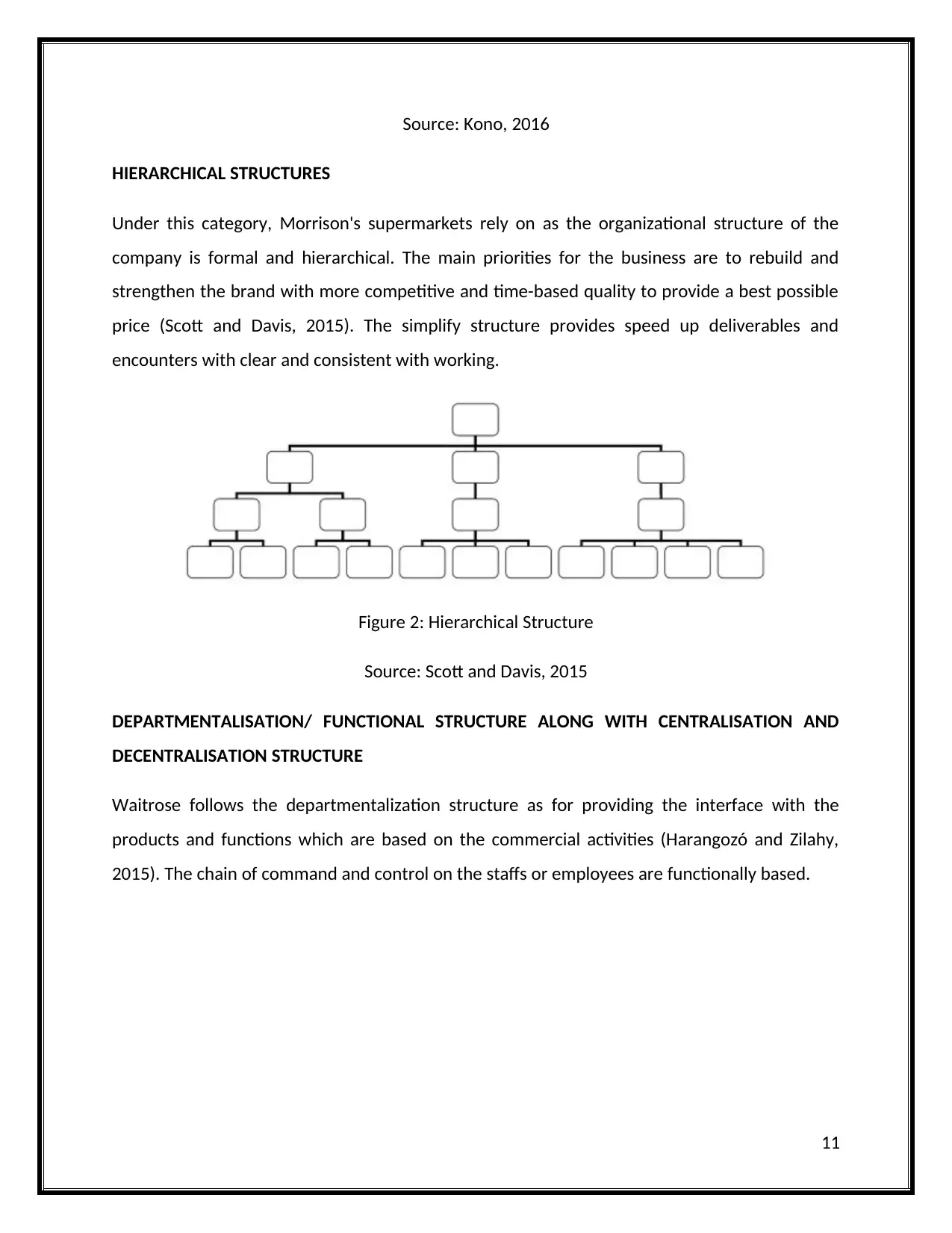
Source: Kono, 2016
HIERARCHICAL STRUCTURES
Under this category, Morrison's supermarkets rely on as the organizational structure of the
company is formal and hierarchical. The main priorities for the business are to rebuild and
strengthen the brand with more competitive and time-based quality to provide a best possible
price (Scott and Davis, 2015). The simplify structure provides speed up deliverables and
encounters with clear and consistent with working.
Figure 2: Hierarchical Structure
Source: Scott and Davis, 2015
DEPARTMENTALISATION/ FUNCTIONAL STRUCTURE ALONG WITH CENTRALISATION AND
DECENTRALISATION STRUCTURE
Waitrose follows the departmentalization structure as for providing the interface with the
products and functions which are based on the commercial activities (Harangozó and Zilahy,
2015). The chain of command and control on the staffs or employees are functionally based.
11
HIERARCHICAL STRUCTURES
Under this category, Morrison's supermarkets rely on as the organizational structure of the
company is formal and hierarchical. The main priorities for the business are to rebuild and
strengthen the brand with more competitive and time-based quality to provide a best possible
price (Scott and Davis, 2015). The simplify structure provides speed up deliverables and
encounters with clear and consistent with working.
Figure 2: Hierarchical Structure
Source: Scott and Davis, 2015
DEPARTMENTALISATION/ FUNCTIONAL STRUCTURE ALONG WITH CENTRALISATION AND
DECENTRALISATION STRUCTURE
Waitrose follows the departmentalization structure as for providing the interface with the
products and functions which are based on the commercial activities (Harangozó and Zilahy,
2015). The chain of command and control on the staffs or employees are functionally based.
11
⊘ This is a preview!⊘
Do you want full access?
Subscribe today to unlock all pages.

Trusted by 1+ million students worldwide
1 out of 26
Related Documents
Your All-in-One AI-Powered Toolkit for Academic Success.
+13062052269
info@desklib.com
Available 24*7 on WhatsApp / Email
![[object Object]](/_next/static/media/star-bottom.7253800d.svg)
Unlock your academic potential
Copyright © 2020–2025 A2Z Services. All Rights Reserved. Developed and managed by ZUCOL.




